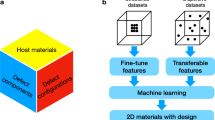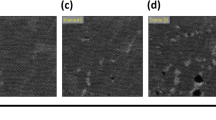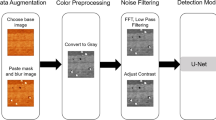Abstract
The extraction of atomic-level material features from electron microscope images is crucial for studying structure-property relationships and discovering new materials. However, traditional electron microscope analyses rely on time-consuming and complex human operations; thus, they are only applicable to images with a small number of atoms. In addition, the analysis results vary due to observers’ individual deviations. Although efforts to introduce automated methods have been performed previously, many of these methods lack sufficient labeled data or require various conditions in the detection process that can only be applied to the target material. Thus, in this study, we developed AtomGAN, which is a robust, unsupervised learning method, that segments defects in classical 2D material systems and the heterostructures of MoS2/WS2 automatically. To solve the data scarcity problem, the proposed model is trained on unpaired simulated data that contain point and line defects for MoS2/WS2. The proposed AtomGAN was evaluated on both simulated and real electron microscope images. The results demonstrate that the segmented point defects and line defects are presented perfectly in the resulting figures, with a measurement precision of 96.9%. In addition, the cycled structure of AtomGAN can quickly generate a large number of simulated electron microscope images.
Similar content being viewed by others
References
Han R, Feng S, Sun D M, et al. Properties and photodetector applications of two-dimensional black arsenic phosphorus and black phosphorus. Sci China Inf Sci, 2021, 64: 140402
Wu S, Wang X, Jiang W, et al. Interface engineering of ferroelectric-gated MoS2 phototransistor. Sci China Inf Sci, 2021, 64: 140407
Yu X, Ng S, Putri L K, et al. Point-defect engineering: leveraging imperfections in graphitic carbon nitride (g-C3N4) photocatalysts toward artificial photosynthesis (small 48/2021). Small, 2021, 17: 2170252
Fu L, Li H, Wang L, et al. Defect passivation strategies in perovskites for an enhanced photovoltaic performance. Energy Environ Sci, 2020, 13: 4017–4056
Sangwan V K, Jariwala D, Kim I S, et al. Gate-tunable memristive phenomena mediated by grain boundaries in single-layer MoS2. Nat Nanotech, 2015, 10: 403–406
Sangwan V K, Lee H S, Bergeron H, et al. Multi-terminal memtransistors from polycrystalline monolayer molybdenum disulfide. Nature, 2018, 554: 500–504
An J, Sun T, Wang B, et al. Efficient graphene in-plane homogeneous p−n−p junction based infrared photodetectors with low dark current. Sci China Inf Sci, 2021, 64: 140403
Wu R, Zhu R Z, Zhao S H, et al. Filling the gap: thermal properties and device applications of graphene. Sci China Inf Sci, 2021, 64: 140401
Yang Y, Zhou J, Zhu F, et al. Determining the three-dimensional atomic structure of an amorphous solid. Nature, 2021, 592: 60–64
Maksov A, Dyck O, Wang K, et al. Deep learning analysis of defect and phase evolution during electron beam-induced transformations in WS2. npj Comput Mater, 2019, 5: 1
Ziatdinov M, Dyck O, Maksov A, et al. Deep learning of atomically resolved scanning transmission electron microscopy images: chemical identification and tracking local transformations. ACS Nano, 2017, 11: 12742–12752
Guo Y, Kalinin S V, Cai H, et al. Defect detection in atomic-resolution images via unsupervised learning with translational invariance. npj Comput Mater, 2021, 7: 180
Cho P, Wood A, Mahalingam K, et al. Defect detection in atomic resolution transmission electron microscopy images using machine learning. Mathematics, 2021, 9: 1209
Choi Y, Choi M, Kim M, et al. StarGAN: unified generative adversarial networks for multi-domain image-to-image translation. In: Proceedings of the 31st IEEE/CVF Conference on Computer Vision and Pattern Recognition (CVPR), Salt Lake City, 2018. 8789–8797
Jain S, Seth G, Paruthi A, et al. Synthetic data augmentation for surface defect detection and classification using deep learning. J Intell Manuf, 2020, 33: 1007–1020
Ren X, Lin W, Yang X, et al. Data augmentation in defect detection of sanitary ceramics in small and non-i.i.d datasets. IEEE Trans Neural Netw Learn Syst, 2022,: 1–10
Lian J, Jia W, Zareapoor M, et al. Deep-learning-based small surface defect detection via an exaggerated local variation-based generative adversarial network. IEEE Trans Ind Inf, 2020, 16: 1343–1351
Cannizzaro D, Varrella A G, Paradiso S, et al. In-situ defect detection of metal additive manufacturing: an integrated framework. IEEE Trans Emerg Top Comput, 2022, 10: 74–86
Tang T W, Kuo W H, Lan J H, et al. Anomaly detection neural network with dual auto-encoders GAN and its industrial inspection applications. Sensors, 2020, 20: 3336
Madsen J, Susi T. The abTEM code: transmission electron microscopy from first principles. Open Res Europe, 2021, 1: 24
Zhu J Y, Park T, Isola P, et al. Unpaired image-to-image translation using cycle-consistent adversarial networks. In: Proceedings of the 16th IEEE International Conference on Computer Vision (ICCV), Venice, 2017. 2242–2251
Zhu J Y, Zhang R, Pathak D, et al. Toward multimodal image-to-image translation. In: Proceedings of the 31st Annual Conference on Neural Information Processing Systems (NIPS), Long Beach, 2017
Goodfellow I J, Pouget-Abadie J, Mirza M, et al. Generative adversarial nets. In: Proceedings of the 28th Conference on Neural Information Processing Systems (NIPS), Montreal, 2014. 2672–2680
Senel H G, Peters R A, Dawant B. Topological median filters. IEEE Trans Image Process, 2002, 11: 89–104
Huh W, Lee D, Lee C. Memristors based on 2D materials as an artificial synapse for neuromorphic electronics. Adv Mater, 2020, 32: 2002092
Lv Z, Xing X, Huang S, et al. Self-assembling crystalline peptide microrod for neuromorphic function implementation. Matter, 2021, 4: 1702–1719
He K, Zhang X, Ren S, et al. Identity mappings in deep residual networks. In: Proceedings of European Conference on Computer Vision, 2016
He K, Zhang X, Ren S, et al. Deep residual learning for image recognition. In: Proceedings of IEEE Conference on Computer Vision and Pattern Recognition (CVPR), Las Vegas, 2016. 770–778
Gong Y, Lin J, Wang X, et al. Vertical and in-plane heterostructures from WS2/MoS2 monolayers. Nat Mater, 2014, 13: 1135–1142
Bhola R, Krishna N H, Ramesh K N, et al. Detection of the power lines in UAV remote sensed images using spectral-spatial methods. J Environ Manage, 2018, 206: 1233–1242
Chaouch H, Charfeddine S, Aoun S B, et al. Multiscale monitoring using machine learning methods: new methodology and an industrial application to a photovoltaic system. Mathematics, 2022, 10: 890
Acknowledgements
This work was supported by National Key R&D Program of China (Grant No. 2022YFB2404303), National Natural Science Foundation of China (Grant Nos. 52107224, 52077096), State Grid Corporation of China (Grant No. 520626210064), and China Postdoctoral Science Foundation (Grant No. 2019M662612).
Author information
Authors and Affiliations
Corresponding author
Rights and permissions
About this article
Cite this article
Cheng, D., Sha, W., Xu, Z. et al. AtomGAN: unsupervised deep learning for fast and accurate defect detection of 2D materials at the atomic scale. Sci. China Inf. Sci. 66, 160410 (2023). https://doi.org/10.1007/s11432-022-3757-x
Received:
Revised:
Accepted:
Published:
DOI: https://doi.org/10.1007/s11432-022-3757-x




